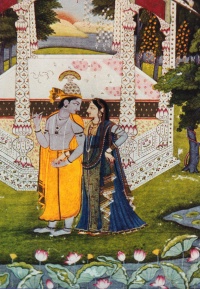Krishna: Difference between revisions
(New page: Lord Krishna Born in Dwapar yug. Category: Mythological References) |
Hari singh (talk | contribs) No edit summary |
||
| Line 1: | Line 1: | ||
{{Showpic|RadheShyam07.jpg|Krishna with Radha, 18th C Rajasthani painting|200}} | |||
'''Lord Krishna''' born in Dwapar yug is a deity worshipped across many traditions of [[Hinduism]]. He is usually depicted as a young cowherd boy playing a flute (such as in the Bhagavata Purana) or a youthful prince giving philosophical direction (as in the Bhagavad Gita). | |||
Most commonly within Hinduism, Krishna is worshipped as an avatar of Vishnu, who is considered the Supreme God by the Vaishnava schools. Within Gaudiya Vaishnavism Krishna is worshipped as the source of all other avatars (including Vishnu). | |||
Krishna and the stories associated with him appear across a broad spectrum of Hindu philosophical and theological traditions. Though they sometimes differ in details reflecting the concerns of a particular tradition, some core features are shared by all. These include a divine incarnation, a pastoral childhood and youth, and life as a heroic warrior and teacher. | |||
{{wikipedia}} | |||
[[Category: Mythological References]] | [[Category: Mythological References]] | ||
Revision as of 11:23, 5 July 2007
Lord Krishna born in Dwapar yug is a deity worshipped across many traditions of Hinduism. He is usually depicted as a young cowherd boy playing a flute (such as in the Bhagavata Purana) or a youthful prince giving philosophical direction (as in the Bhagavad Gita).
Most commonly within Hinduism, Krishna is worshipped as an avatar of Vishnu, who is considered the Supreme God by the Vaishnava schools. Within Gaudiya Vaishnavism Krishna is worshipped as the source of all other avatars (including Vishnu).
Krishna and the stories associated with him appear across a broad spectrum of Hindu philosophical and theological traditions. Though they sometimes differ in details reflecting the concerns of a particular tradition, some core features are shared by all. These include a divine incarnation, a pastoral childhood and youth, and life as a heroic warrior and teacher.
- See Wikipedia article on Krishna for more information

